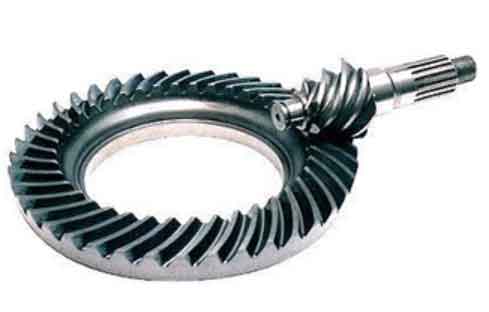When it comes to optimizing efficiency in hypoid gear systems, several design considerations can be taken into account. Here are some important factors to consider:

- Gear Geometry: The geometry of the hypoid gear, including the tooth profile, helix angle, and gear ratio, plays a crucial role in determining its efficiency. Optimizing these parameters can help reduce friction, minimize power losses, and improve overall efficiency.
- Lubrication: Proper lubrication is essential for reducing friction and wear in hypoid gear systems. Design considerations should include provisions for effective lubricant delivery to the gear teeth and bearings. The selection of the appropriate lubricant and regular maintenance are also critical for maintaining efficiency.
- Tooth Profile: The tooth profile of hypoid gears should be designed to minimize sliding friction and ensure smooth rolling contact. Optimizing the tooth shape, such as modifying the tooth curvature and contact pattern, can help improve efficiency and reduce noise and vibration.
- Surface Finish: The surface finish of the gear teeth has a significant impact on efficiency. Smoother surfaces reduce friction and wear, leading to improved efficiency. Proper finishing processes, such as grinding or honing, should be employed to achieve the desired surface finish.
- Material Selection: Choosing the right materials for hypoid gears is crucial for optimizing efficiency. High-quality, durable materials with good strength and fatigue resistance can help reduce friction and wear, thus improving efficiency. Additionally, materials with low friction coefficients, such as certain coatings or surface treatments, can be considered to further enhance efficiency.
- Bearing Design: The design and selection of bearings in a hypoid gear system can affect overall efficiency. Proper bearing selection, including the type, size, and quality, is important for reducing friction and ensuring smooth rotation of the gears.
- Housing Design: The design of the gear housing or gearbox should be optimized to minimize losses due to churning and windage. Proper sealing, ventilation, and cooling provisions can help reduce internal losses and improve efficiency.
- Manufacturing Precision: The manufacturing precision of hypoid gears is critical for achieving high efficiency. Tight tolerances, accurate gear cutting, and proper alignment of the gears during assembly are essential to minimize misalignment, backlash, and other sources of inefficiency.
- Noise and Vibration: Excessive noise and vibration in a hypoid gear system can indicate energy losses. Design considerations should focus on reducing noise and vibration through careful gear geometry, proper alignment, and the use of noise-dampening measures, such as vibration-absorbing materials or coatings.
- System Integration: The overall integration of the hypoid gear system within the larger mechanical system should be considered. Proper alignment, load distribution, and compatibility with other components can contribute to efficient power transmission and minimize losses.
It is worth noting that optimizing efficiency in hypoid gear systems often requires a balance between various factors, and design trade-offs may be necessary based on the specific application requirements. Working closely with experienced gear designers and considering real-world operating conditions can help ensure the best possible efficiency in a given hypoid gear system.
